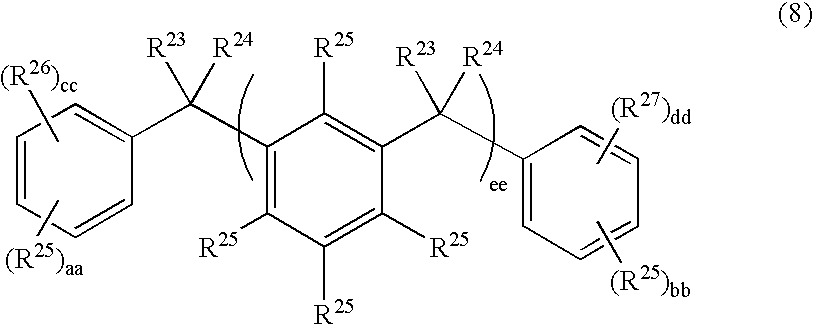Positive-type photosensitive polyimide precursor composition
a polyimide precursor and photosensitive technology, applied in the direction of photosensitive materials, instruments, photomechanical equipment, etc., can solve the problems of poor solvent resistance of polyimide resin obtained, inability to obtain desired patterns, and limited structur
- Summary
- Abstract
- Description
- Claims
- Application Information
AI Technical Summary
Problems solved by technology
Method used
Image
Examples
synthesis example 1
Synthesis of naphthoquinone diazide compound (1)
10.1 g (0.05 mol) of 4,4-dihydroxydiphenyl ether (result of calculation of dipole moment based on MOPAC-97=0.73 debye) and 47.0 g (0.175 mol) of 4-naphthoquinone diazide sulphonyl chloride were dissolved in 500 g of 1,4-dioxane under a current of dry nitrogen, and then warmed to 40.degree. C. To this there was added, dropwise, 17.7 g (0.175 mol) of triethylamine mixed with 50 g of 1,4-dioxane, in such a way that the internal temperature of the system did not rise to more than 45.degree. C. Following the dropwise addition, stirring was carried out for 2 hours at 40.degree. C. The by-product triethylamine hydrochloride was filtered off and the filtrate poured into 3 litres of 1% hydrochloric acid, after which the precipitate which was deposited was collected by filtering. Washing was carried out twice with 10 litres of water, and drying performed for 20 hours in a vacuum dryer at 50.degree. C. Naphthoquinone diazide compound (1) was obta...
synthesis example 2
Synthesis of naphthoquinone diazide compound (2)
17.4 g (0.05 mol) of bis(4-hydroxyphenyl)2,2-dicyclohexylpropane (result of calculation of dipole moment based on MOPAC-97=0.23 debye) and 34.9 g (0.13 mol) of 5-naphthoquinone diazide sulphonyl chloride were dissolved in 400 g of 1,4-dioxane under a current of dry nitrogen, and then warmed to 40.degree. C. To this there was added, dropwise, 13.1 g (0.13 mol) of triethylamine mixed with 40 g of 1,4-dioxane, and naphthoquinone diazide compound (2) obtained in the same way as in Synthesis Example 1. (On average, 2.6 of the Q groups=5-naphthoquinone diazide sulphonyl groups and the remainder=hydrogen.) ##STR22##
synthesis example 3
Synthesis of naphthoquinone diazide compound (3)
13.2 g (0.05 mol) of 3,3'-dimethyl-4,4'-dihydroxyphenyl thioether (result of calculation of dipole moment based on MOPAC-97=1.59 debye) and 34.9 g (0.13 mol) of 5-naphthoquinone diazide sulphonyl chloride were dissolved in 400 g of 1,4-dioxane under a current of dry nitrogen, and then warmed to 40.degree. C. To this there was added, dropwise, 13.1 g (0.13 mol) of triethylamine mixed with 40 g of 1,4-dioxane, and naphthoquinone diazide compound (3) obtained in the same way as in Synthesis Example 1. (On average, 1.3 of the Q groups=5-naphthoquinone diazide sulphonyl groups and 0.7=hydrogen.) ##STR23##
(On average, 1.3 of the Q groups=5-naphthoquinone diazide sulphonyl groups and 0.7=hydrogen.)
PUM
| Property | Measurement | Unit |
|---|---|---|
| dipole moment | aaaaa | aaaaa |
| mol % | aaaaa | aaaaa |
| mol % | aaaaa | aaaaa |
Abstract
Description
Claims
Application Information
 Login to View More
Login to View More - R&D
- Intellectual Property
- Life Sciences
- Materials
- Tech Scout
- Unparalleled Data Quality
- Higher Quality Content
- 60% Fewer Hallucinations
Browse by: Latest US Patents, China's latest patents, Technical Efficacy Thesaurus, Application Domain, Technology Topic, Popular Technical Reports.
© 2025 PatSnap. All rights reserved.Legal|Privacy policy|Modern Slavery Act Transparency Statement|Sitemap|About US| Contact US: help@patsnap.com



